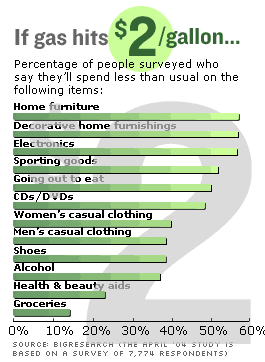NEW YORK (CNN/Money) -
As gasoline prices snake higher, the nation's discount retailers are starting to feel the heat.
At the other end of the retail spectrum, however, high-end retailers may feel little impact since their typical customers are less affected.
Wal-Mart Stores (WMT: Research, Estimates), the world's biggest retailer, raised a red flag Thursday when CEO Lee Scott said he estimated that the recent jump in gasoline prices was taking an average of $7 out of the typical Wal-Mart customer's disposable income each week.

Indeed, Wal-Mart's same-store sales -- or sales at stores open at least a year -- were sluggish in April, rising 4.4 percent for the month and narrowly missing Wall Street's forecasts for a 4.5 percent increase.
According to industry watchers, historically it is discounters such as Wal-Mart, Target and Kmart that have suffered the most when gasoline prices jump.
"The risk to retailers is moderate right now because the [gas] price increases are hurting consumers more at the low-income spectrum. But these are also consumers who shop more frequently at discount stores like Wal-Mart," said Michael Niemira, chief economist with the International Council of Shopping Centers.
Conference Board economist Delos Smith agreed.
"We're going to see people trimming their expenses here and there. They probably will not eat out as much or go to movies as often as they normally would. So restaurants and theaters are also vulnerable," said Smith.
Indeed, consumers typically react to higher gasoline prices with much grumbling since it forces them to cut back on buying that extra pair of shoes, summer dress or CD collection.
The average price of a gallon of unleaded regular jumped almost 10 cents last week to $1.94 a gallon. That's up 45 cents a gallon from a year ago, the government said this week and warned that prices could hit a record $2.03 a gallon by June.
Richard Hastings, chief retail analyst with Bernard Sands, thinks the threshold level for consumers is $2.75 a gallon.
"That's when consumer spending will really pull back and retail sales across the board will suffer."
Retailers that could escape the price squeeze, according to Hastings, are the high-end retailers that have posted some of the strongest comparable-store sales growth this year, as well as pet supply and auto supply chains.
"Anecdotal evidence shows that while people will cut back on buying for themselves to pay for gas, they will continue to spend on their kids and their pets," said Hastings.
Target and Kmart could not immediately be reached for comment.

|

